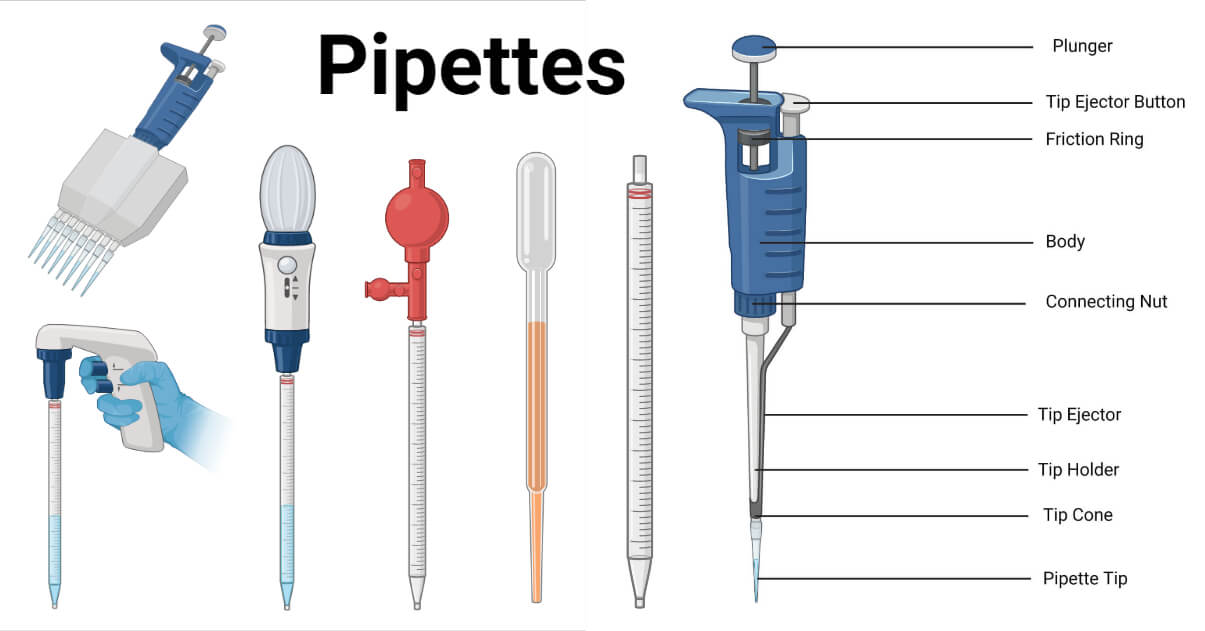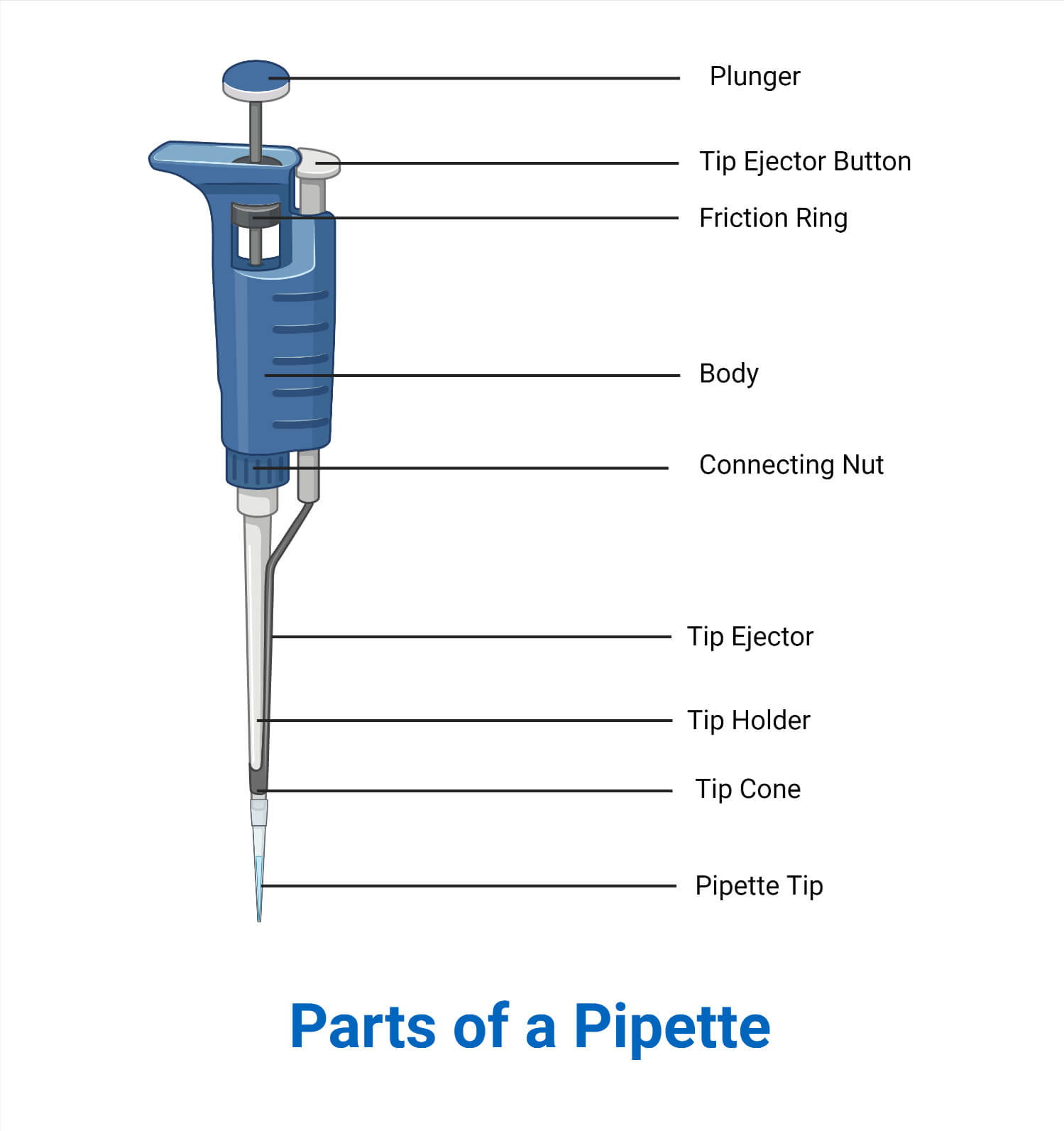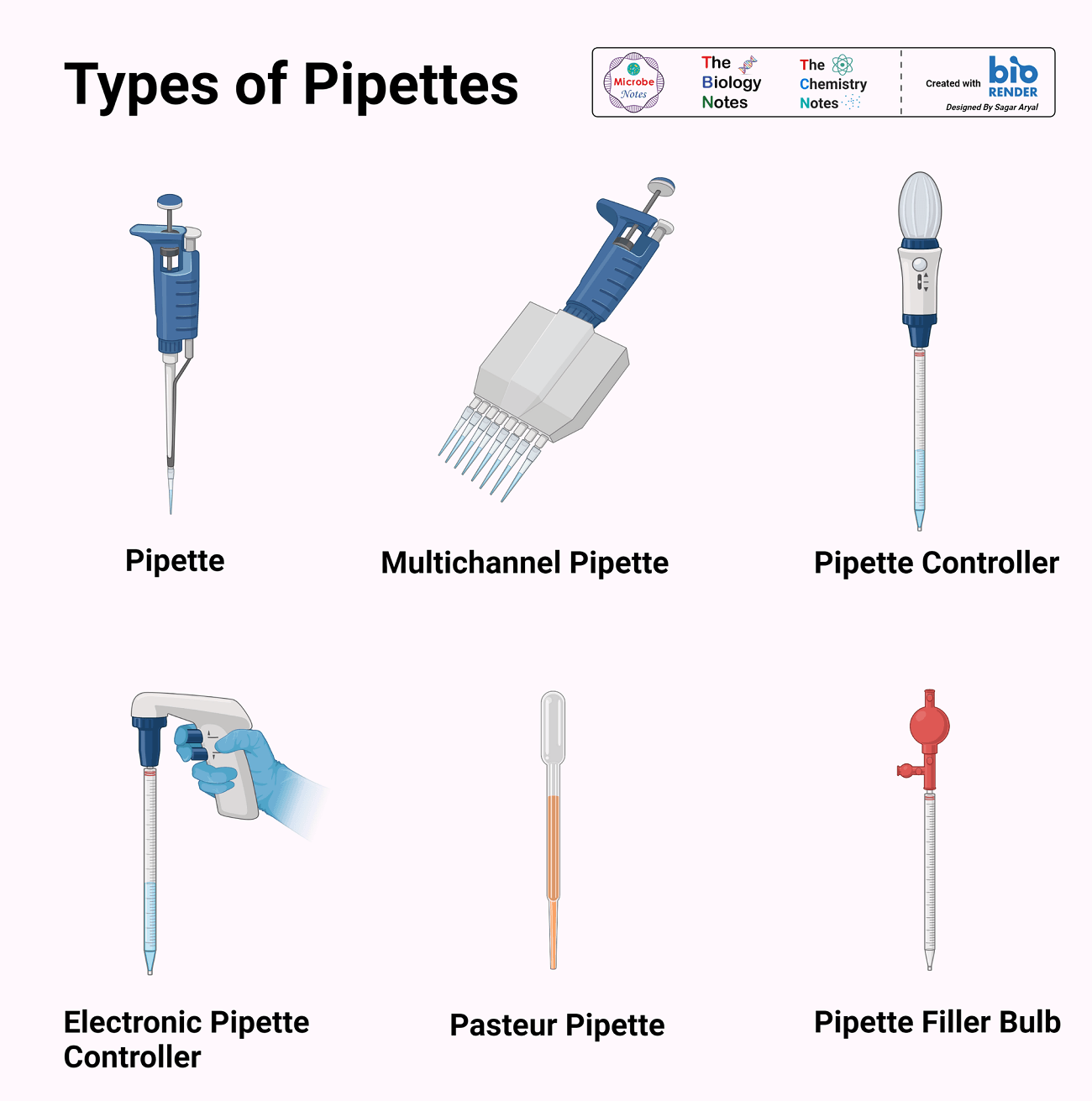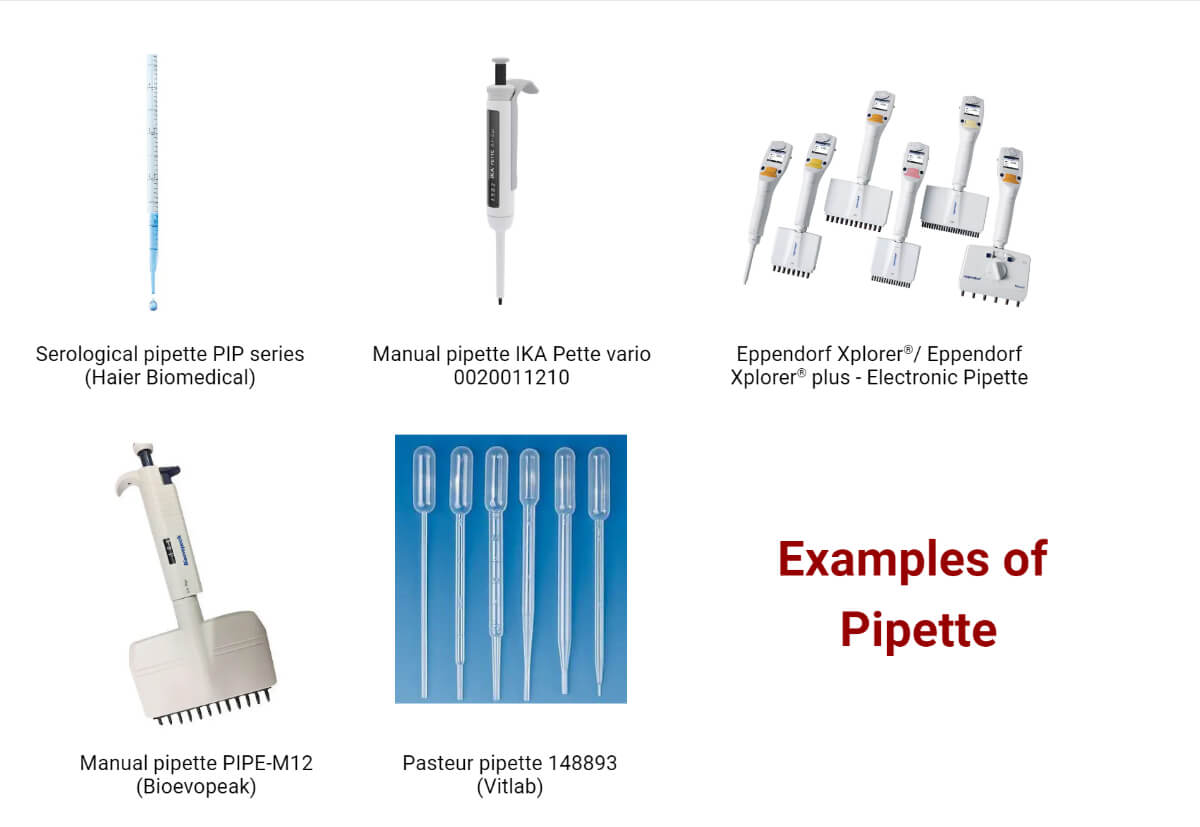A pipette is a lab device used to measure out or dispense small amounts of liquid in volumes of milliliters (mL) or microliters (μL).
The name “pipette” is derived from the French word “pipette,” which means “small pipe”. Pipettes come in three basic varieties: glass, plastic, and electronic. Glass pipettes are constructed of borosilicate glass, plastic pipettes are made of polyethylene terephthalate (PET), and microprocessors run electronic pipettes. Pipettes made of plastic and glass are commonly used to measure volumes under 1 milliliter (mL).

The smallest volume measured with an electronic pipette is 0.1 microliters (μL). Pipettes typically start at 1 milliliter, whereas micropipettes have a measurement range of 1 to 1000 µl. It is employed in a wide range of experiment procedures in chemistry, molecular biology (biotechnology), medical research, experiments in the general field of natural science, analysis of food and chemicals, food safety inspections, and clinical examination inspections.
Interesting Science Videos
Principle of Pipette
The pipette’s working principle is based mainly on two mechanisms, namely, the air displacement method and the positive displacement method. Each type of pipette has a piston that moves inside a capillary or cylinder. A specific amount of air is left between the piston and the liquid in air displacement pipettes. In positive displacement pipetting, the piston makes direct contact with the fluid.
Air displacement method: The telescoping movement of the spring enables the piston to suction and discharge liquids. In response to the piston’s push, some air is let out, the liquid is drawn in by atmospheric pressure, and the air is subsequently forced out to release the liquid. Because of this, it is possible to manage the pace and force of the pipetting while using a pipette because it is operated using the spring’s expansion and contraction characteristics. It is mostly employed for pipettes.
Positive displacement method: Repeated pipettes or specialized positive displacement pipettes frequently employ the positive displacement principle. Direct contact with the liquid is made by a disposable piston that moves inside the tip. The sample is then drawn into the tip by the piston’s upward movement (Air cushion is absent as with air displacement pipettes). As the piston descends, the chosen volume is discharged.
Parts of Pipette

Several parts of the pipette are described below:
Plunger: It is used to aspirate and dispense the desired volume of liquids.
Ejector button: It causes the metal bar to descend, ejecting the pipette tip.
Volume Adjustment Knob: The volume of the sample to be transferred can be set by rotating the volume adjustment knob to increase and decrease the concentration. It cannot be rotated in a fixed-volume pipette.
Volume window: It displays the set volume, and the place values shown depend on pipette size.
Shaft: It is a tube-like structure filled with air in an air displacement pipette. When the piston is pressed, some air from the shaft is released, aiding in liquid aspiration. In contrast, releasing the piston aids in liquid dispensing while refilling the shaft with air.
Tip cone: It is the area where the pipette tip is attached.
Pipette tip: It is a piece of equipment made of polypropylene or plastic that has been molded into it and comes into contact with the liquid.
Types of Pipette
Pasteur Pipettes
It is also known as eye droppers or simply droppers. Conventionally, they are made from glass, although plastic Pasteur Pipettes have superseded them These are specifically intended to mediate the transfer of small amounts of liquids. These tubes are joined at the upper end by a plastic or rubber bulb and taper down to a small orifice at the bottom end. Teat pipette is a term for combining a glass Pasteur pipette and a rubber bulb.

Volumetric pipettes
It is also known as bulby pipette or belly pipette. It is commonly used in analytical chemistry in making laboratory solutions from stock and preparing solutions for titration. Its bulb is sizable, and its part is long and thin. They are most effective for quick measurements since they may be calibrated to give a precise set volume of liquid with an accuracy of up to 4 significant digits.
Graduated pipettes
Graduated pipettes are those that have indicated volume increments alongside the tube. These pipettes, which come in various shapes, are frequently employed for straightforward solution transfers. They frequently have a tapered tip and are constructed of glass or strong plastic. Graduated pipettes can be divided into Type 1, Type 2, and Type 3 categories based on their construction. All volumes of type 1 pipettes have partially deliverable solutions. In contrast, type 2 pipettes have zero at the bottom and the nominal value at the top, and type 3 pipettes exclusively supply the solution at the nominal value. Mohr pipettes and serological pipettes are the two main categories of graduated pipettes.
i) Serological pipettes
These are utilized in the laboratory for gentle mixing of cell suspensions, reagents, and chemical solutions, creating gradients in reagent layering, transferring liquid (a few mL to 100 mL), and volumetric measurements. Serological pipettes make it possible for cells to spread equitably throughout a solution, which is essential for cell culture.
ii) Mohr’s pipettes
The scale of a Mohr pipette is divided into units of one and one-tenth of a milliliter. It is less precise than a volumetric pipette due to its wide neck. When taking a large number of solutions where precision is not a high priority, they are used. They can release liquid gradually and are filled similarly to volumetric ones.
iii) Transfer pipettes
These are disposable transfer pipettes, one of the graduated pipettes that serve as a great alternative to Pasteur pipettes since one has to no more worry about the hazards of broken glass and cross-contamination between samples. They are employed in blood banking, urinalysis, wet chemistry, microbiology, hematology, and serology. The low affinity of the unbreakable low-density polyethylene plastic surface of these pipettes reduces the loss of cells and desired proteins due to binding as they are inert to biological fluids and acids.
Vacuum-assisted Pipettes
Both graded and volumetric vacuum-assisted pipettes are available. While volumetric vacuum-assisted pipettes only measure a single volume and hence only have one graduation mark, graduated vacuum-assisted pipettes use multiple graduation marks. Polystyrene, glass, or borosilicate are used to create vacuum-assisted pipettes. They lack pistons but need a suction device.
Repeater pipette
Repeater pipettes are perfect for dispensing the same quantities repeatedly into several receptacles without pausing in between each dispensing process, enhancing speed and efficiency. These are lightweight and only require one hand to operate, enabling a single operator to work at a throughput capacity.
Single channel pipettes Vs. Multichannel pipettes
A single-channel pipette is a non-disposable instrument with an air-displacement design that generates precise measurement results using a single disposable tip. A multichannel pipette is comparable to a single-channel pipette, except it may hold many tips simultaneously. The liquid is aspirated simultaneously from the same well into various channels.
Both manual and electronic single-channel variable volume and fixed volume pipettes are provided, where the manual one is the most economical and the traditional design. In contrast, the electronic micropipette is expensive and has several advantages, such as improved ergonomics, fewer user-to-user variances, and more accuracy and precision.
Manual Vs. Electronic pipette
A manual pipette uses the mechanical effort of a thumb to move the piston (up to 3cm), while electronic pipettes are designed to improve ergonomics by reducing the necessary force. Electronic pipettes thus substitute a tiny battery-powered electric motor for manual input.
Fixed Vs. adjustable volume pipette
Fixed-volume pipettes are best suited for working with dense or viscous liquids. The pipette’s volume can’t be altered in a fixed volume pipette which facilitates the user to operate more quickly without having to adjust the volume often. In contrast, an adjusted volume pipette has the volume changing the setting on the side or top. Thus, a fixed volume pipette is less prone to errors, and its calibration is considerably simpler and quicker than an adjustable volume pipette.
Specific purpose pipette
These pipettes are devised for specific purposes, such as environmental hormone analysis with glass tip Micropipettes and high-volume ultra macro-pipettes with a 50-milliliter volume dispensing capacity. Van Slyke pipettes, Ostwald-Folin pipettes, glass micropipettes, microfluidic pipettes, and extremely low-volume pipettes are a few examples of specialty pipettes.
Operating Procedure
The points listed below mention handling a pipette (disposable one).
- Take a tip out of the tip box by loading it into the pipette.
- Using the volume adjustment spinning dial, adjust the volume to be transferred.
- While maintaining a vertical grip on the pipette, press the plunger to the first stop.
- Place the tip inside the liquid component being sampled.
- With the tip still submerged, slowly release the plunger to draw up the liquid. If the liquid is viscous, pause briefly at the very end.
- Place the pipette’s tip inside the tube or container where the liquid is collected.
- Completely depress the plunger until it stops at the second stop point to deposit the liquid into the appropriate tube.
- Press the ejector button to remove the used tip and place it in the proper garbage can.
Applications of Pipette
- It facilitates the even distribution of cells in cell seeding and avoids foaming and bubble formation.
- It allows easy media exchange of T-flask cell cultures and maintains the sterility of the cultures, and prevents contamination.
- 96 well microplates, frequently used in microplate applications like ELISA, PCR, or cell culture, are compatible with multichannel pipettes of 8 or 12-channel variants.
- To aliquot, a reagent into several doses- a process known as multi-dispensing- electronic pipettes are employed.
- Serological pipettes are employed in conventional laboratory settings and applications involving cell and tissue culture.
Advantages of Pipette
- Pipettes are comfortable to use and are more user-friendly.
- It is safer to handle hazardous chemicals as compared to measuring cylinders.
- Volumetric pipettes are extremely accurate and give precise measurements while delivering solutions. The narrow neck of the volumetric pipette facilitates the meniscus to be read more accurately.
- Electronic pipettes increase productivity in the lab by saving time and reducing the likelihood of human error.
- Multichannel pipettes are ideal for high accuracy, efficiency, and reproducibility of high throughput experiments.
- It can be used with various liquids, including foamy liquids, high vapor pressure liquids, and liquids with a high viscosity.
Limitations of Pipette
- Volumetric pipettes are more costly, and their measurements are fixed and specific to the individual volumetric pipette.
- Graduated pipettes are not precise when delivering and measuring liquid and bear a wider margin of human-use error.
Precautions
- Fill a pipette to the brim and drain it against the receiving vessel’s interior wall. Never force any potentially harmful substance out of a pipette.
- To reduce aerosol generation, carefully remove the disposable pipette tips. The aerosol formation will be reduced by a wetted towel placed in the bottom of the dispensing container, which is frequently a glass beaker.
- Mechanical pipetting equipment is utilized; mouth pipetting is not permitted.
- Place reusable pipettes horizontally in a pan with enough liquid disinfectant to cover them completely.
Examples of Pipette
Serological pipette PIP series (Haier Biomedical)
- Serum pipettes are appropriate for cell and tissue cultivation, as well as other biological research.
- They are constructed of high-clarity polystyrene and come in paper-plastic bags that are individually wrapped.
- Different colors are used to distinguish pipettes of various diameters.
- No cytotoxicity, hemolysis, or pyrogens are present.

Manual pipette IKA Pette vario 0020011210 (IKA)
- IKA pipettes come with replaceable grips in a variety of designs and materials. As a result, certainly, they will comfortably fit in the palm.
- High-quality carbon with a diamond-like finish is applied to the tip cone and piston (DLC).
- The tip cone’s resistance to impact, UV rays, and chemicals guarantee long-term, dependable dosing.
Electronic pipette Xplorer®/Xplorer® plus (Eppendorf SE)
- Simple, quick, and accurate with constant battery power.
- The single, 8, 12, 16, and 24-channel Eppendorf Xplorer electronic pipettes are created to aspirate and dispense liquid volumes from 0.5 μL to 10 mL while removing many potential mistake risks connected with manual pipetting.
Manual pipette PIPE-M12 (Bioevopeak)
- The volume range for pipettes is 0.5 μL to 300 μL.
- Large display windows make loudness identification simple.
- 96 well plates are suitable for 12-channel pipettes.
- Dispensing head revolves for convenient, easy pipetting.
- A tip cone built of composite material ensures strong sealing performance.
Pasteur pipette 148893 (Vitlab)
- It is disposable. The amount of drops per milliliter has excellent consistency, making it perfect for distributing liquid quantities in aliquots.
- Pasteur pipettes can be deep frozen when full or, if necessary, heated-sealed to create sealed vessels. It is simple to compress the inbuilt suction bulb.
- Gas or gamma radiation can be used to sterilize.
References
- https://www.labmate-online.com/news/laboratory-products/3/breaking-news/a-brief-guide-of-pipette-types/30746
- https://solutions.pipette.com/pipette-types/
- https://wp.stolaf.edu/chemical-hygiene/good-pipetting-techniques/
- https://www.labcompare.com/General-Laboratory-Equipment/1265-Pipettes-Micropipettes/
- https://www.nichiryo.co.jp/en/productline/pipette.html
- https://www.coleparmer.com/blog/2022/05/08/different-types-of-pipettes/
- https://www.mrclab.com/a-guide-to-understanding-pipettes
- https://www.ivdconsumablesupplier.com/news/classification-and-working-principle-of-pipett-47168674.html
- https://www.brand.de/brand/contentserv_data/Context/BRAND%20GMBH%20%2B%20CO%20KG/Dokumente/Produkte/Application-Technical%20Notes/Application%20notes/Liquid%20Handling/Technical_Note_Luftpolsterpipette_Mehrfachdispenser_EN.pdf
- Aqlan, F., Huang, Y., Walters, E.G., & Meanazel, O.T. (2017). Enhancing ergonomic design skills among undergraduate students by integrating Computer Aided Design and Digital Human Modeling.
- https://www.thermofisher.com/np/en/home/life-science/lab-plasticware-supplies/lab-plasticware-supplies-learning-center/lab-plasticware-supplies-resource-library/fundamentals-of-pipetting/liquid-handling-selection/pipette-types-for-different-applications.html
- https://www.medicalexpo.com/prod/haier-biomedical/product-299012-1069968.html
- https://www.medicalexpo.com/prod/ika/product-70924-891619.html
- https://www.medicalexpo.com/prod/eppendorf-se/product-68382-445758.html
- https://www.medicalexpo.com/prod/vitlab/product-112294-742139.html
